MaxEnt-Based Evaluation of Cultivated Land Suitability in the Lijiang River Basin, China
Abstract
1. Introduction
2. Materials and Methods
2.1. Study Area
2.2. MaxEnt Model
2.3. Model Parameter Settings
2.4. Data Sources and Processing
2.4.1. Cultivated Land Data Sources and Processing
2.4.2. Data Sources and Processing of Restriction Factors
2.5. Restriction Factor Screening
2.6. Classification of Suitable Areas
3. Results
3.1. Analysis of Model Run Results
3.2. Distribution of Suitable Areas for Paddy Fields and Analysis of Major Restriction Factors
3.2.1. Distribution of Suitable Areas for Paddy Fields
3.2.2. The Main Restriction Factors for Suitability for Paddy Fields
- (1)
- Distance to villages. The response curve of the suitability of paddy fields for distance to villages is given in Figure 7a. As the distance to villages increases, the general suitability of paddy fields exhibits a constant declining trend. When the distance to villages is less than 0.83 km, the area is suitable for paddy fields (P > 0.5), with the most favorable distance to villages being 0.016 km (Pmax); when the distance to villages exceeds 2.45 km, the area is unsuitable for paddy fields (<0.2).
- (2)
- Slope. The response curve of slope for the suitability of paddy fields is given in Figure 7b. As the slope increases, the general suitability of paddy fields exhibits a declining trend. When the slope is less than 3.8°, the suitability of paddy fields is relatively high (P > 0.5), with the optimal slope being 0° (Pmax). When the slope is larger than 18.1°, the area is unsuitable for paddy fields (P < 0.2).
- (3)
- Surface gravel content. The response curve of surface gravel content for the suitability of paddy fields is shown in Figure 7c. As the surface gravel content increases, the suitability of paddy fields exhibits a constant declining trend. When the surface gravel content is less than 20.1%, the area is suitable for paddy fields (P > 0.5), with the ideal surface gravel content being 0.7% (Pmax). When the surface gravel content exceeds 29.7%, the area is unsuitable for paddy fields (P < 0.2).
- (4)
- Soil thickness. The response curve of soil thickness for the suitability of paddy fields is given in Figure 7d. As soil thickness increases, the suitability for paddy fields first increases and subsequently falls. When the soil thickness exceeds 101 cm, the area is suitable for paddy fields (P > 0.5), with the optimal soil thickness being 124 cm (Pmax). When the soil thickness is less than 92 cm, the area is unsuitable for paddy fields (P < 0.2).
- (5)
- Soil pH. The response curve of soil pH for the suitability of paddy fields is depicted in Figure 7e. As soil pH increases, the suitability of paddy fields first increases and then decreases. When the soil pH exceeds 5.7, the area is suitable for paddy fields (P > 0.5), with the most suitable soil pH being 6.5 (Pmax); when soil pH is less than 5.3, the area is unsuitable for paddy fields (P < 0.2).
- (6)
- Total phosphorus content. The response curve of total phosphorus content for the suitability of paddy fields is depicted in Figure 7f. As total phosphorus content increases, the suitability of paddy fields exhibits an upward trend. When the total phosphorus content is greater than 32.1 g/kg, the area is suitable for paddy fields (P > 0.5), with the optimal total phosphorus content being 37.4 g/kg (Pmax); when the total phosphorus content is less than 27.9 g/kg, the area is unsuitable for paddy fields (P < 0.2).
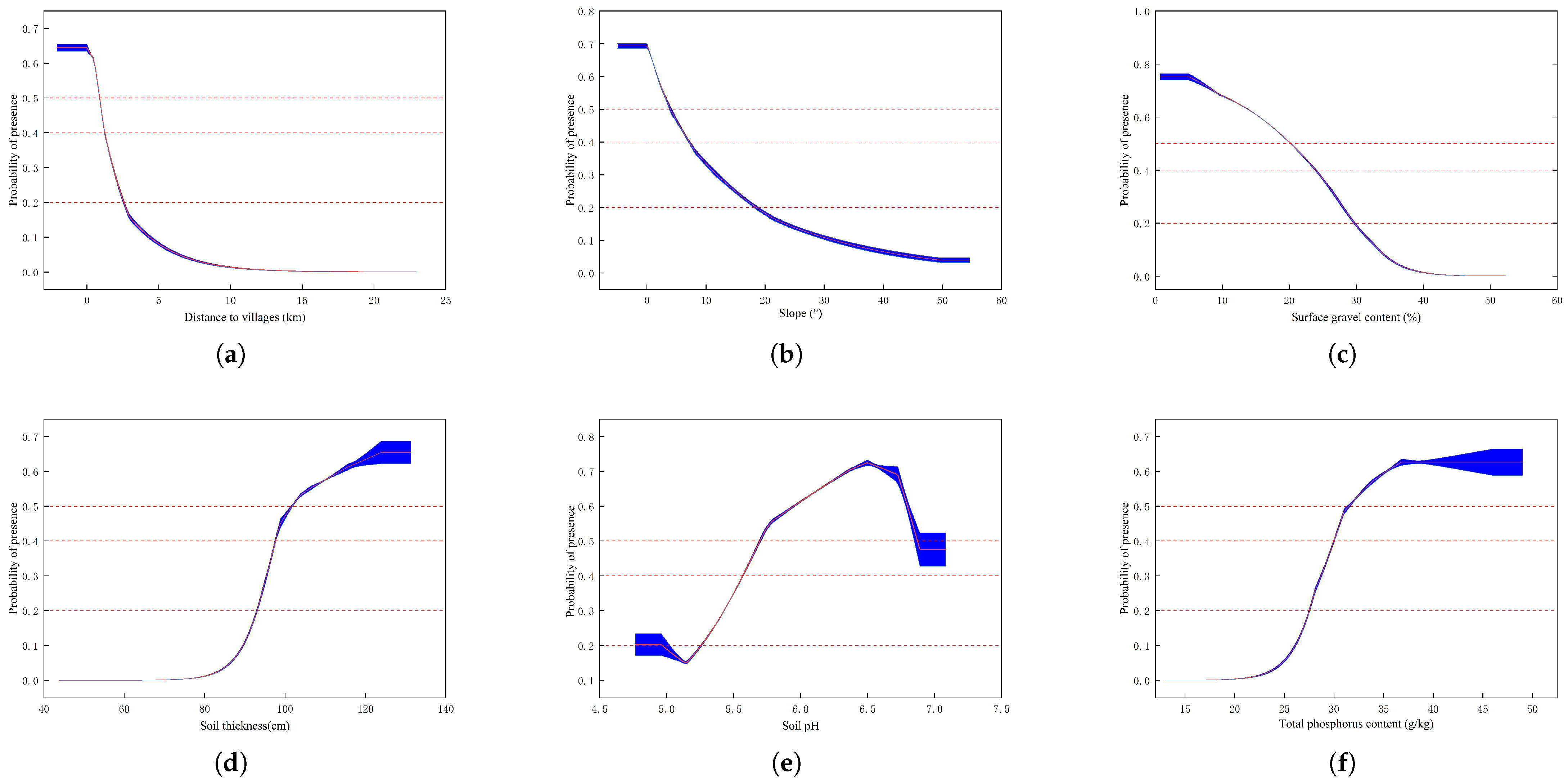
3.3. Distribution of Suitable Areas for Drylands and Analysis of Major Restriction Factors
3.3.1. Distribution of Suitable Areas for Drylands
3.3.2. The Main Restriction Factor for Suitability for Drylands
- (1)
- Soil thickness. The response curve of soil thickness for the suitability for dryland is shown in Figure 9a. As soil thickness increases, the overall suitability of dryland shows an upward trend. When soil thickness is greater than 97 cm, the area is relatively suitable for dryland (P > 0.5), with the optimal soil thickness being 110 cm (Pmax); when soil thickness is less than 85 cm, the land is unsuitable for dryland (P < 0.2).
- (2)
- Distance to roads. The response curve for distance to roads and suitability for dryland is illustrated in Figure 9b. With increasing distance to roads, the overall suitability for dryland shows a downward trend. When the distance to roads is less than 3.95 km, the area is relatively suitable for dryland (P > 0.5), with the optimal distance to roads being 0.1 km (Pmax). When the distance to roads exceeds 13.5 km, the area is unsuitable for dryland (P < 0.2).
- (3)
- Surface gravel content. The response curve of surface gravel content for the suitability for dryland is shown in Figure 9c. As the surface gravel content increases, the suitability for drylands exhibits a constant declining trend. When the surface gravel content is less than 23.5%, the area is suitable for drylands (P > 0.5), with the ideal surface gravel content being 17.7% (Pmax). When the surface gravel content exceeds 36.5%, the area is unsuitable for dryland (P < 0.2).
- (4)
- Elevation. The response curve of elevation for the suitability for dryland is shown in Figure 9d. With increasing elevation, the suitability for dryland shows a continuous downward trend. When the elevation is <286 m, the land is relatively suitable for dryland (P > 0.5), with the most suitable elevation being 155 m (Pmax); when the elevation is >683 m, the area is unsuitable for dryland (P < 0.2).
- (5)
- Soil pH. The response curve of soil pH for the suitability for dryland is depicted in Figure 9e. With increasing soil pH, the overall suitability for dryland shows a continuous upward trend. When the soil pH > 5.5, the soil is relatively suitable for dryland (P > 0.5), with the ideal soil pH being 6.8 (Pmax).
- (6)
- Soil texture. The soil texture in the LRB is primarily composed of six types: sandy loam, loam, silt loam, sandy clay loam, clay loam, silt clay loam, and clay. The response curves of soil texture for the suitability for dryland are illustrated in Figure 9f. The soil texture types ideal for dryland are silt loam, sandy clay loam, and clay loam (P > 0.5). With sandy clay loam being the most suitable (Pmax). The soil textures in the LRB are generally suitable for dryland (P > 0.2).


4. Discussion
5. Conclusions
Author Contributions
Funding
Institutional Review Board Statement
Informed Consent Statement
Data Availability Statement
Acknowledgments
Conflicts of Interest
References
- Wu, Z.; Fan, Q.; Li, W.; Zhou, Y. The Spatial–Temporal Evolution and Impact Mechanism of Cultivated Land Use in the Mountainous Areas of Southwest Hubei Province, China. Land 2024, 13, 1946. [Google Scholar] [CrossRef]
- Yu, Z.; Kuang, L.; Jiang, Y.; Li, W.; Zhang, J.; Zhou, Y.; Guo, X.; Ye, Y. Soil attributes are more important than others in shaping the diversity of cultivated land quality types, southern China. Ecol. Indic. 2024, 166, 112472. [Google Scholar] [CrossRef]
- Fan, Y.; Ning, W.; Liang, X.; Wang, L.; Lv, L.; Li, Y.; Wang, J. Spatial–Temporal Characteristics and Influencing Factors of Eco-Efficiency of Cultivated Land Use in the Yangtze River Delta Region. Land 2024, 13, 219. [Google Scholar] [CrossRef]
- Du, Z.; Gao, B.; Ou, C.; Du, Z.; Yang, J.; Batsaikhan, B.; Dorjgotov, B.; Yun, W.; Zhu, D. A Quantitative Analysis of Factors Influencing Organic Matter Concentration in the Topsoil of Black Soil in Northeast China Based on Spatial Heterogeneous Patterns. ISPRS Int. J. Geo-Inf. 2021, 10, 348. [Google Scholar] [CrossRef]
- Zhu, X.; Xiao, G.; Wang, S. Suitability evaluation of potential arable land in the Mediterranean region. J. Environ. Manag. 2022, 313, 115011. [Google Scholar] [CrossRef] [PubMed]
- Maddahi, Z.; Jalalian, A.; Zarkesh, M.K.; Honarjo, N. Land suitability analysis for rice cultivation using multi criteria evaluation approach and GIS. Eur. J. Exp. Biol. 2014, 4, 639–648. [Google Scholar]
- Han, C.; Chen, S.; Yu, Y.; Xu, Z.; Zhu, B.; Xu, X.; Wang, Z. Evaluation of agricultural land suitability based on RS, AHP, and MEA: A case study in Jilin Province, China. Agriculture 2021, 11, 370. [Google Scholar] [CrossRef]
- Samanta, S.; Pal, B.; Pal, D.K. Land suitability analysis for rice cultivation based on multi-criteria decision approach through GIS. Int. J. Sci. Emerg. Technol. 2011, 2, 12–20. [Google Scholar]
- Sathiyamurthi, S.; Saravanan, S.; Karuppannan, S.; Balakumbahan, R.; Sivasakthi, M.; Praveen Kumar, S.; Ramya, M.; Hussain, S.; Tariq, A. Agricultural land suitability of Manimutha Nadhi watershed using AHP and GIS techniques. Discov. Sustain. 2024, 5, 270. [Google Scholar] [CrossRef]
- Dutta, A.; Banerjee, M.; Ray, R. Land capability assessment of Sali watershed for agricultural suitability using a multi-criteria-based decision-making approach. Environ. Monit. Assess. 2024, 196, 237. [Google Scholar] [CrossRef]
- Yao, M.; Shao, D.; Lv, C.; An, R.; Gu, W.; Zhou, C. Evaluation of arable land suitability based on the suitability function—A case study of the Qinghai-Tibet Plateau. Sci. Total Environ. 2021, 787, 147414. [Google Scholar] [CrossRef]
- Kuang, L.; Ye, Y.; Guo, X.; Xie, W.; Zhao, X. Spatiotemporal variation of cultivated land security and its drivers: The case of Yingtan City. China. J. Resour. Ecol. 2021, 12, 280–291. [Google Scholar]
- Radočaj, D.; Jurišić, M. GIS-based cropland suitability prediction using machine learning: A novel approach to sustainable agricultural production. Agronomy 2022, 12, 2210. [Google Scholar] [CrossRef]
- Yu, X.; Tao, X.; Liao, J.; Liu, S.; Xu, L.; Yuan, S.; Zhang, Z.; Wang, F.; Deng, N.; Huang, J.; et al. Predicting potential cultivation region and paddy area for ratoon rice production in China using Maxent model. Field Crops Res. 2022, 275, 108372. [Google Scholar] [CrossRef]
- Fan, Y.; Wei, M.; Li, M.; Su, Z.; Liu, H. Spatio-Temporal Dynamic Impacts of Land Use/Cover Change on Eco-Environment Quality in Li River Basin, China. Sustainability 2025, 17, 1299. [Google Scholar] [CrossRef]
- Wang, H.; Li, Y.; Cheng, S.; Yuan, W.; Bai, X.; Ma, Y.; Yu, Z.; Yu, L.; Wang, B.; Guo, W. Analysis of changes in the ecohydrological situation and its driving forces in the Li River Basin. J. Water Clim. Change 2025, 16, 361–379. [Google Scholar] [CrossRef]
- Chu, Y.; Tang, X.; Zhong, X. Spatial–Temporal Variations in Water Use Efficiency and Its Influencing Factors in the Li River Basin, China. Water 2024, 16, 2864. [Google Scholar] [CrossRef]
- Dong, S.; Mo, Y.; Ma, J. Research progress on ecology and sustainable development of Guilin Lijiang River Basin, China, based on bibliometric analysis. Environ. Sci. Pollut. Res. 2024, 31, 6694–6722. [Google Scholar] [CrossRef]
- Cao, Y.; Zhang, J.; Yang, M.; Lei, X.; Guo, B.; Yang, L.; Zeng, Z.; Qu, J. Application of SWAT model with CMADS data to estimate hydrological elements and parameter uncertainty based on SUFI-2 algorithm in the Lijiang River Basin, China. Water 2018, 10, 742. [Google Scholar] [CrossRef]
- Phillips, S.J.; Anderson, R.P.; Schapire, R.E. Maximum entropy modeling of species geographic distributions. Ecol. Model. 2006, 190, 231–259. [Google Scholar] [CrossRef]
- Gan, T.; Qian, Q.; Liu, Z.; Xu, D. Simulation of Suitable Distribution Areas of Magnolia officinalis in China Based on the MaxEnt Model and Analysis of Key Environmental Variables. Agriculture 2024, 14, 2303. [Google Scholar] [CrossRef]
- Warren, D.L.; Seifert, S.N. Ecological niche modeling in Maxent: The importance of model complexity and the performance of model selection criteria. Ecol. Appl. 2011, 21, 335–342. [Google Scholar] [CrossRef] [PubMed]
- Bradie, J.; Leung, B. A quantitative synthesis of the importance of variables used in MaxEnt species distribution models. J. Biogeogr. 2017, 44, 1344–1361. [Google Scholar] [CrossRef]
- Campos, J.C.; Garcia, N.; Alírio, J.; Arenas-Castro, S.; Teodoro, A.C.; Sillero, N. Ecological niche models using MaxEnt in Google Earth Engine: Evaluation, guidelines and recommendations. Ecol. Inform. 2023, 76, 102147. [Google Scholar] [CrossRef]
- Gong, L.; Li, X.; Wu, S.; Jiang, L. Prediction of potential distribution of soybean in the frigid region in China with MaxEnt modeling. Ecol. Inform. 2022, 72, 101834. [Google Scholar] [CrossRef]
- Zhao, Y.; Deng, X.; Xiang, W.; Chen, L.; Ouyang, S. Predicting potential suitable habitats of Chinese fir under current and future climatic scenarios based on Maxent model. Ecol. Inform. 2021, 64, 101393. [Google Scholar] [CrossRef]
- Ali, S.; Umair, M.; Makanda, T.A.; Shi, S.; Hussain, S.A.; Ni, J. Modeling Current and Future Potential Land Distribution Dynamics of Wheat, Rice, and Maize under Climate Change Scenarios Using MaxEnt. Land 2024, 13, 1156. [Google Scholar] [CrossRef]
- Fitzgibbon, A.; Pisut, D.; Fleisher, D. Evaluation of Maximum Entropy (Maxent) machine learning model to assess relationships between climate and corn suitability. Land 2022, 11, 1382. [Google Scholar] [CrossRef]
- Heng, S.; Li, N.; Yang, Q.; Liang, J.; Liu, X.; Wang, Y. Effects of environment and human activities on rice planting suitability based on MaxEnt model. Int. J. Biometeorol. 2024, 68, 2413–2429. [Google Scholar] [CrossRef]
- Kang, Y.; Lin, F.; Yin, J.; Han, Y.; Zhu, M.; Guo, Y.; Tang, F.; Li, Y. Projected distribution patterns of Alpinia officinarum in China under future climate scenarios: Insights from optimized Maxent and Biomod2 models. Front. Plant Sci. 2025, 16, 1517060. [Google Scholar] [CrossRef]
- Shi, J.; Xia, M.; He, G.; Gonzalez, N.C.; Zhou, S.; Lan, K.; Ouyang, L.; Shen, X.; Jiang, X.; Cao, F.; et al. Predicting Quercus gilva distribution dynamics and its response to climate change induced by GHGs emission through MaxEnt modeling. J. Environ. Manag. 2024, 357, 120841. [Google Scholar] [CrossRef]
- Bai, J.; Wang, H.; Hu, Y. Prediction of Potential Suitable Distribution of Liriodendron chinense (Hemsl.) Sarg. in China Based on Future Climate Change Using the Optimized MaxEnt Model. Forests 2024, 15, 988. [Google Scholar] [CrossRef]
- He, Y.; Ma, J.; Chen, G. Potential geographical distribution and its multi-factor analysis of Pinus massoniana in China based on the maxent model. Ecol. Indic. 2023, 154, 110790. [Google Scholar] [CrossRef]
- Zhao, R.; Wang, S.; Chen, S. Predicting the potential habitat suitability of saussurea species in China under future climate scenarios using the optimized maximum entropy (maxent) model. J. Clean. Prod. 2024, 474, 143552. [Google Scholar] [CrossRef]
- Zhang, F.G.; Liang, F.; Wu, K.; Xie, L.; Zhao, G.; Wang, Y. The potential habitat of Angelica dahurica in China under climate change scenario predicted by Maxent model. Front. Plant Sci. 2024, 15, 1388099. [Google Scholar] [CrossRef] [PubMed]
- Luo, J.; Ma, Y.; Liu, Y.; Zhu, D.; Guo, X. Predicting Polygonum capitatum distribution in China across climate scenarios using MaxEnt modeling. Sci. Rep. 2024, 14, 20020. [Google Scholar] [CrossRef]
- Dong, J.; Bai, T.; Gao, Z.S.; Yang, S.W.; Zhang, J.L.; Wu, Y.W. Prediction of potential habitat areas of Rhododendron delavayi in China based on maximum entropy model MaxEnt. Front. For. Glob. Change 2024, 7, 1360823. [Google Scholar] [CrossRef]
- Liu, J.; Kuang, W.; Zhang, Z.; Xu, X.; Qin, Y.; Ning, J.; Zhou, W.; Zhang, S.; Li, R.; Yan, C.; et al. Spatiotemporal characteristics, patterns, and causes of land-use changes in China since the late 1980s. J. Geogr. Sci. 2014, 24, 195–210. [Google Scholar] [CrossRef]
- Li, S.; Wang, Z.; Zhu, Z.; Tao, Y.; Xiang, J. Predicting the potential suitable distribution area of Emeia pseudosauteri in Zhejiang Province based on the MaxEnt model. Sci. Rep. 2023, 13, 1806. [Google Scholar] [CrossRef]
- Ali, S.; Makanda, T.A.; Umair, M.; Ni, J. MaxEnt model strategies to studying current and future potential land suitability dynamics of wheat, soybean and rice cultivation under climatic change scenarios in East Asia. PLoS ONE 2023, 18, e0296182. [Google Scholar] [CrossRef]
- Shi, X.; Wang, J.; Zhang, L.; Chen, S.; Zhao, A.; Ning, X.; Fan, G.; Wu, N.; Zhang, L.; Wang, Z. Prediction of the potentially suitable areas of Litsea cubeba in China based on future climate change using the optimized MaxEnt model. Ecol. Indic. 2023, 148, 110093. [Google Scholar] [CrossRef]
- Gao, X.; Liu, J.; Huang, Z. The impact of climate change on the distribution of rare and endangered tree Firmiana kwangsiensis using the Maxent modeling. Ecol. Evol. 2022, 12, e9165. [Google Scholar] [CrossRef] [PubMed]
- Hou, J.; Xiang, J.; Li, D.; Liu, X. Prediction of potential suitable distribution areas of Quasipaa spinosa in China based on MaxEnt optimization model. Biology 2023, 12, 366. [Google Scholar] [CrossRef]
- Ji, W.; Gao, G.; Wei, J. Potential global distribution of Daktulosphaira vitifoliae under climate change based on MaxEnt. Insects 2021, 12, 347. [Google Scholar] [CrossRef]
- Chi, Y.; Wang, G.G.; Zhu, M.; Jin, P.; Hu, Y.; Shu, P.; Wang, Z.; Fan, A.; Qian, P.; Han, Y.; et al. Potentially suitable habitat prediction of Pinus massoniana Lamb. in China under climate change using Maxent model. Front. For. Glob. Change 2023, 6, 1144401. [Google Scholar] [CrossRef]
- Choudhary, K.; Boori, M.; Shi, W.; Valiev, A.; Kupriyanov, A. Agricultural land suitability assessment for sustainable development using remote sensing techniques with analytic hierarchy process. Remote Sens. Appl. Soc. Environ. 2023, 32, 101051. [Google Scholar] [CrossRef]
- Wotlolan, D.L.; Lowry, J.H.; Wales, N.A.; Glencross, K. Land suitability evaluation for multiple crop agroforestry planning using GIS and multi-criteria decision analysis: A case study in Fiji. Agrofor. Syst. 2021, 95, 1519–1532. [Google Scholar] [CrossRef]
- Tang, M.; Wang, C.; Ying, C.; Mei, S.; Tong, T.; Ma, Y.; Wang, Q. Research on Cultivated Land Quality Restriction Factors Based on Cultivated Land Quality Level Evaluation. Sustainability 2023, 15, 7567. [Google Scholar] [CrossRef]
- Peijun, W.; Ziqi, L.; Jing, W.; Yali, Y.; Shouguo, M. Spatiotemporal evolution patterns and driving factors of arable land in Huaihai Economic Zone, China. Front. Environ. Sci. 2023, 11, 1267475. [Google Scholar]
- Dong, J.; Yun, W.; Wu, K.; Li, S.; Liu, B.; Lu, Q. Spatio-Temporal Analysis of Cultivated Land from 2010 to 2020 in Long’an County, Karst Region, China. Land 2023, 12, 515. [Google Scholar] [CrossRef]
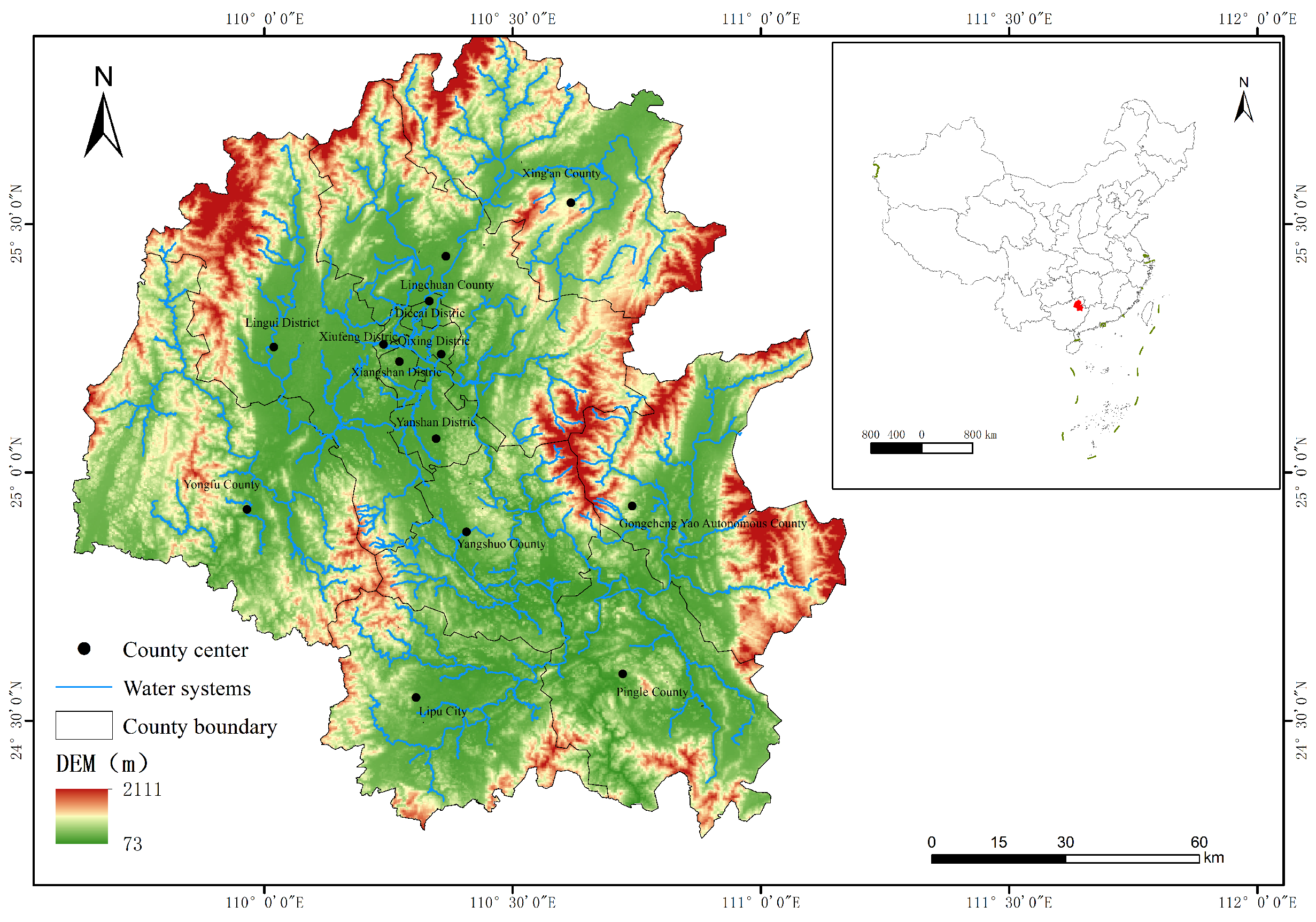
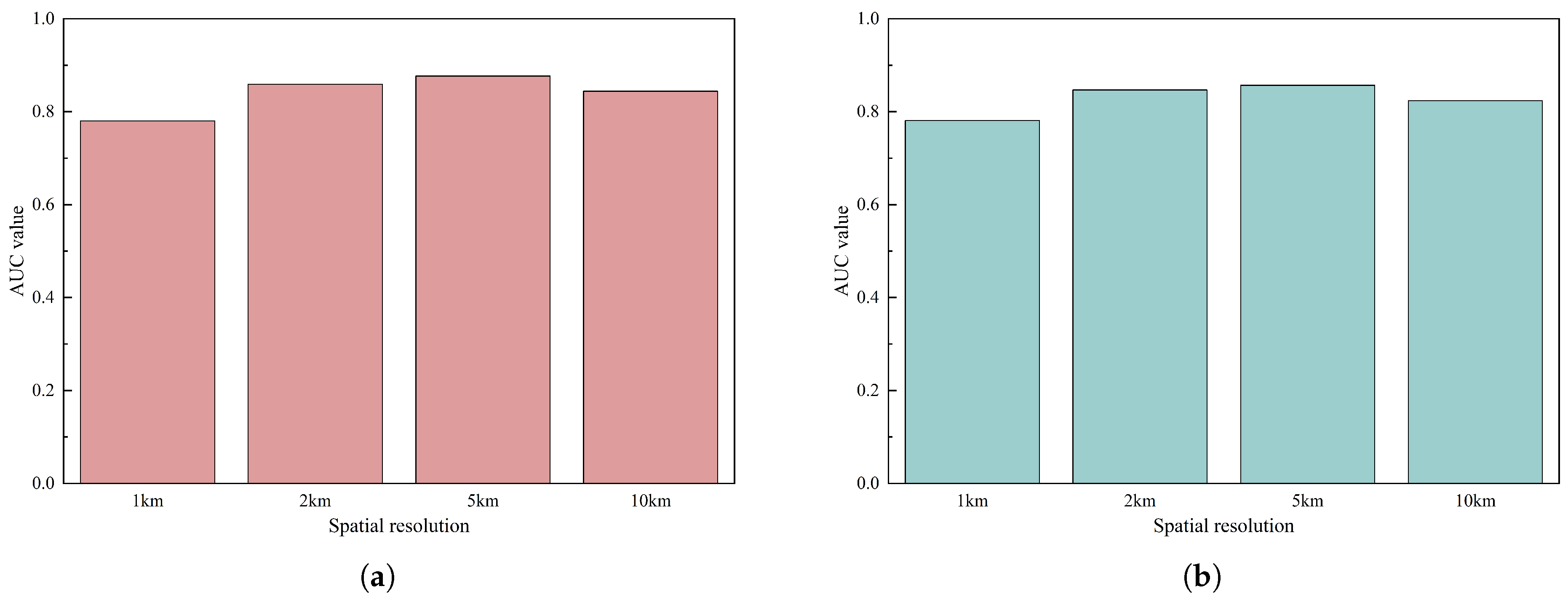
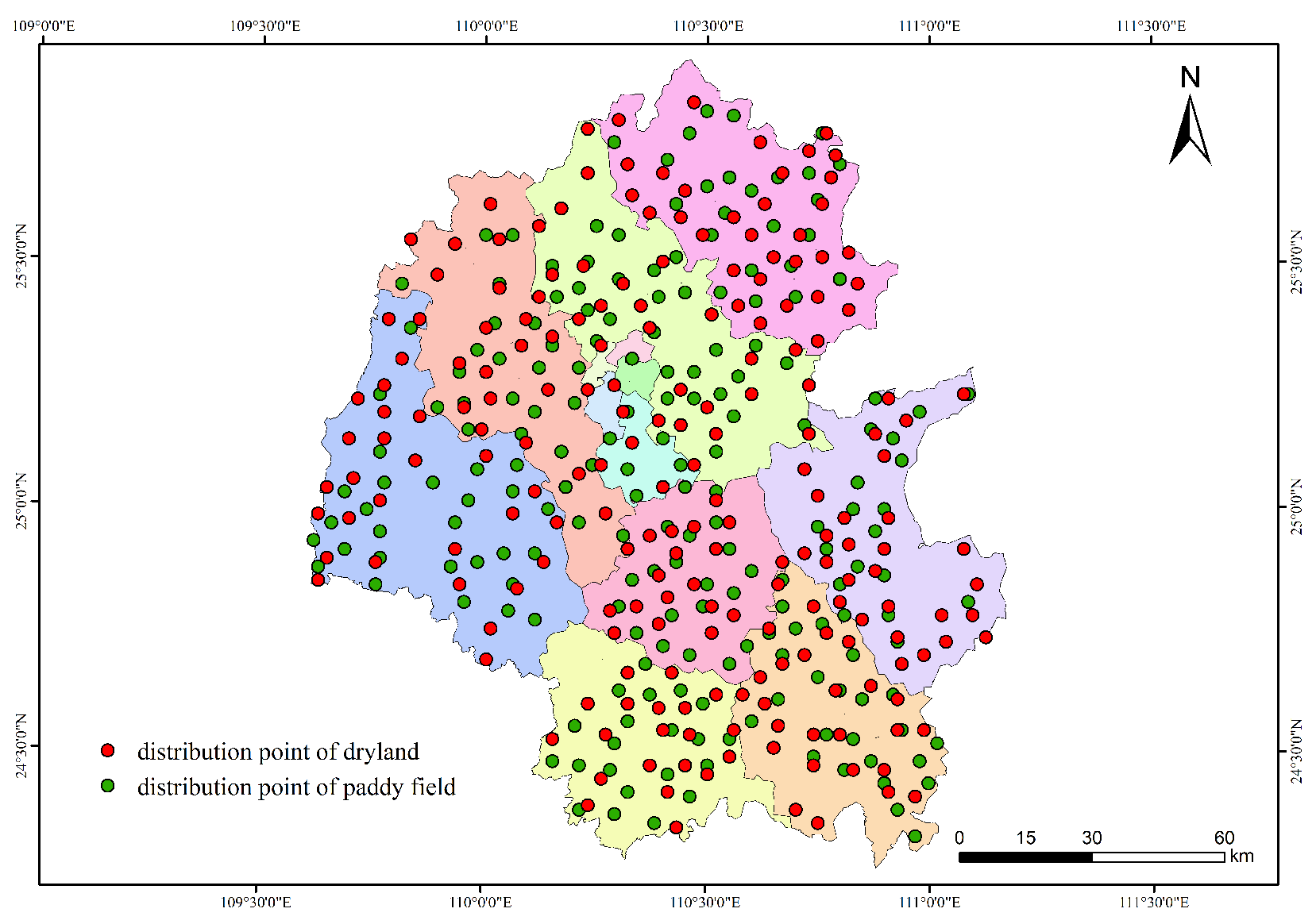
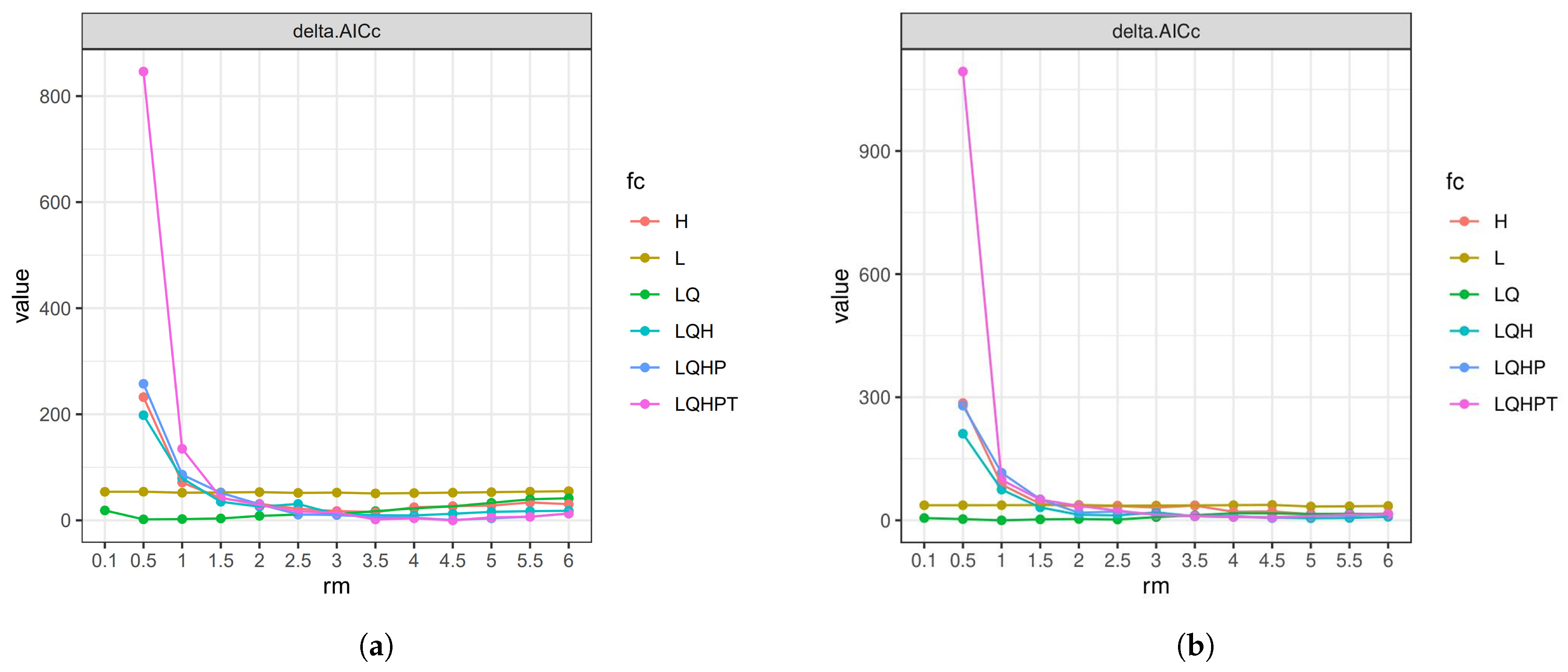
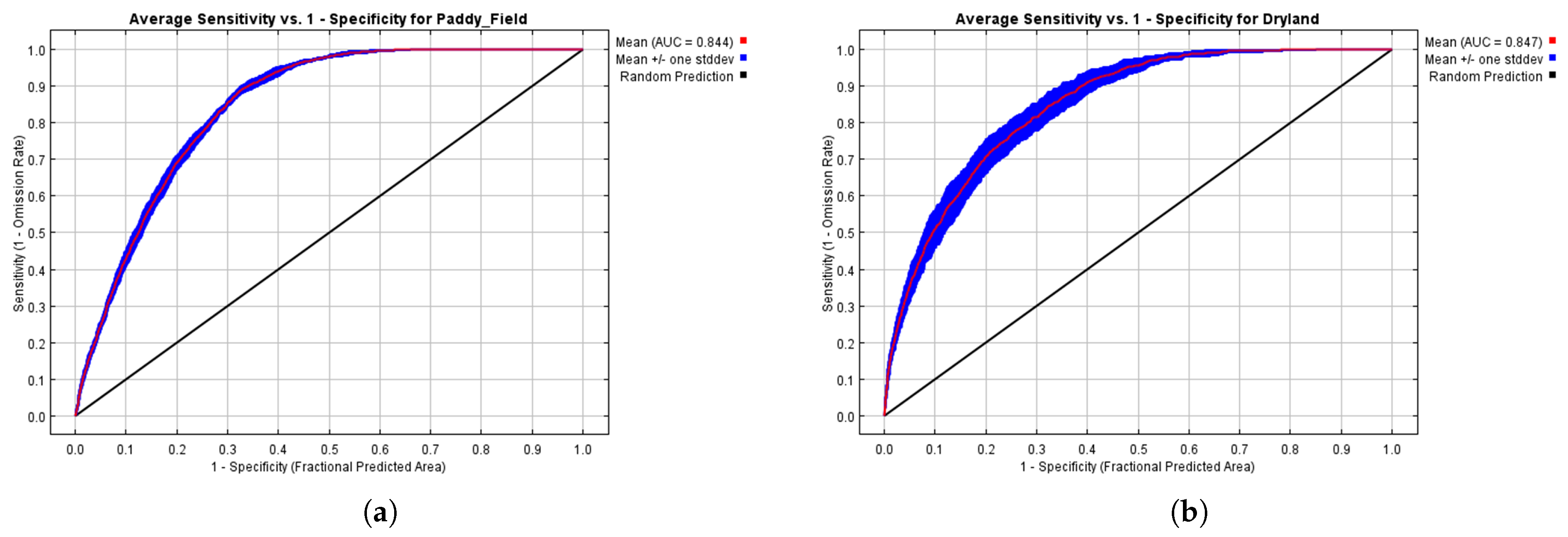
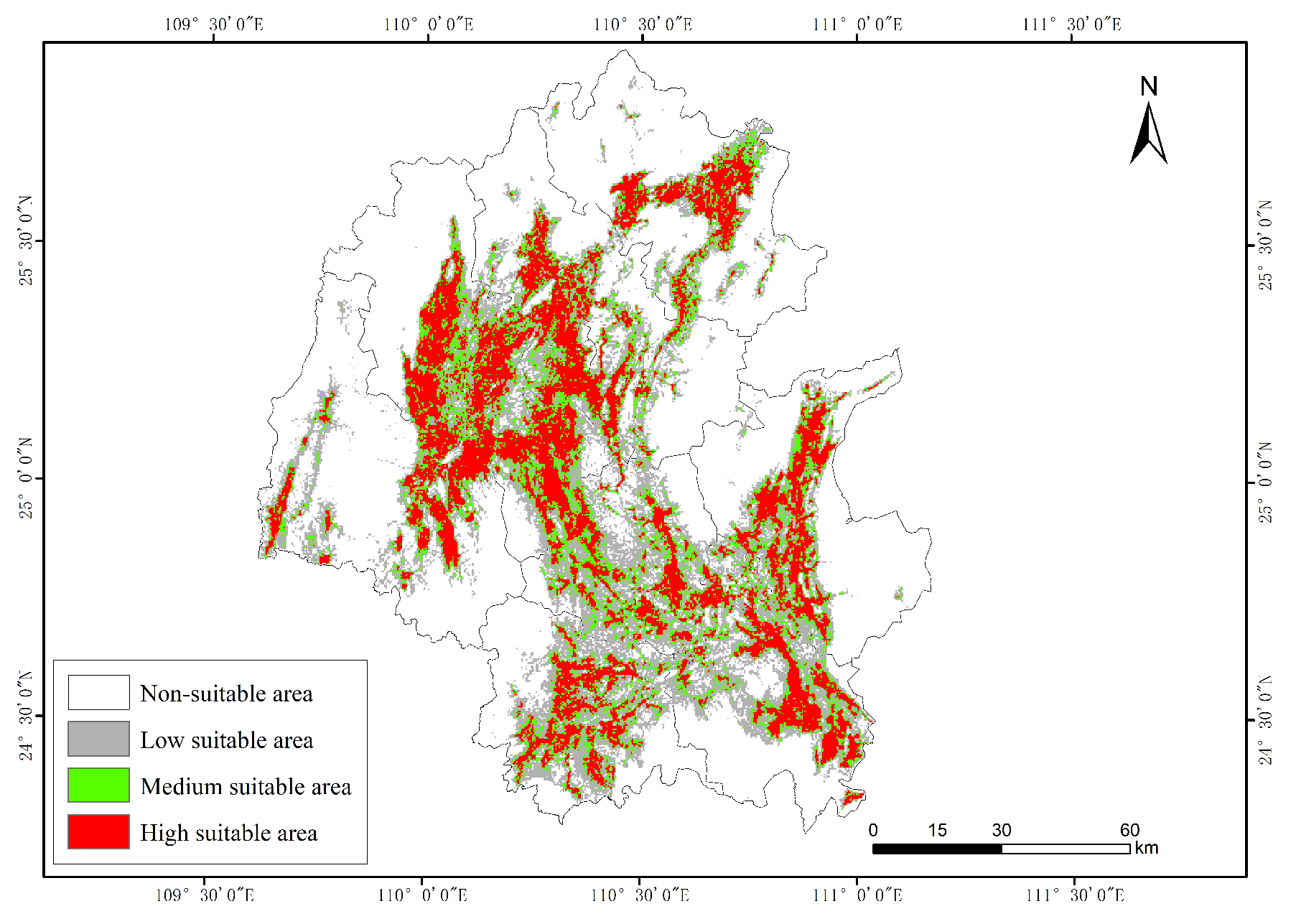
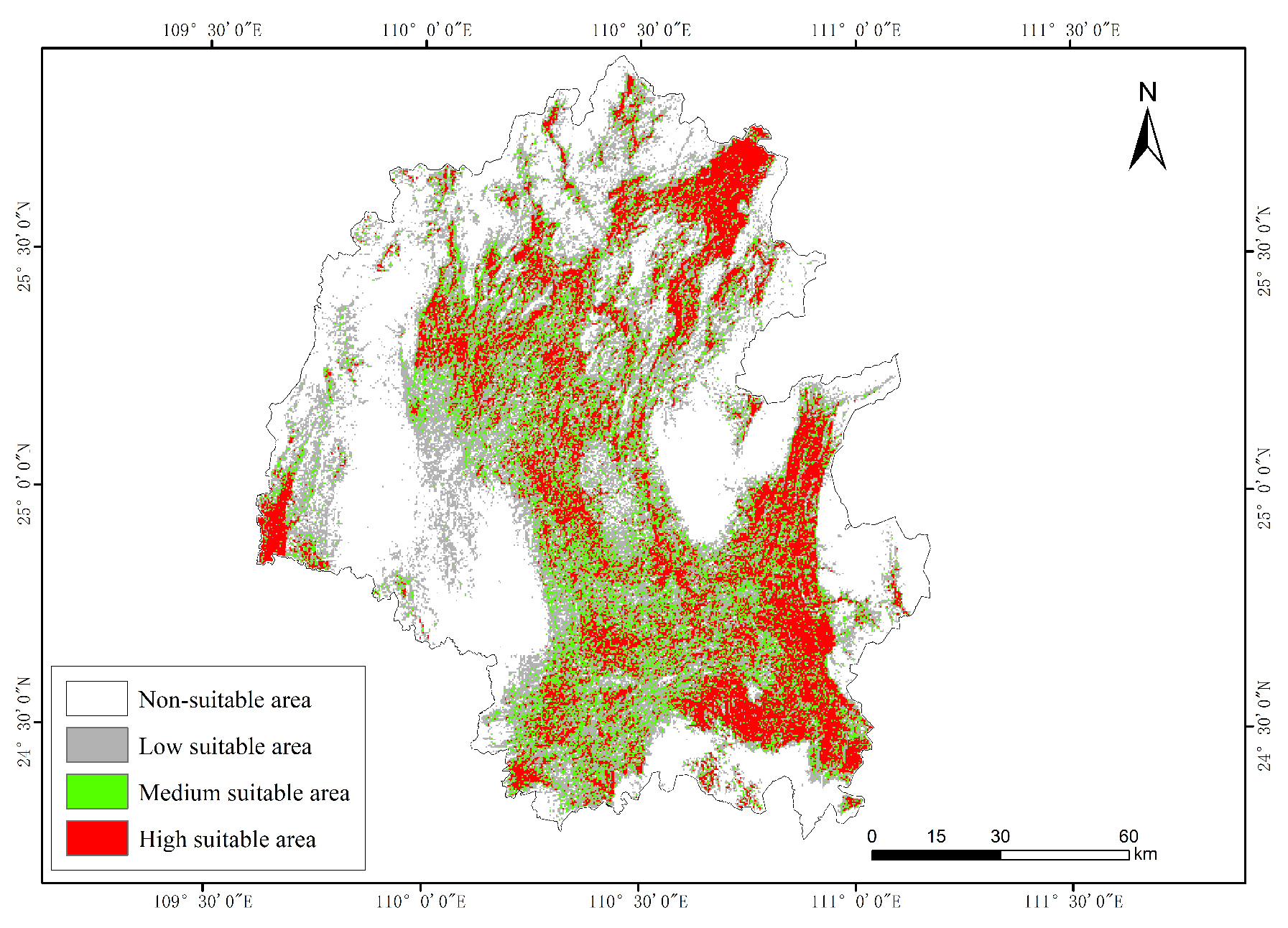
| Data Type | Restriction Factor | Description | Data Source |
|---|---|---|---|
| Climate Data | AAP (mm) | Average annual precipitation | “National Tibetan Plateau Science Data Center” (http://data.tpdc.ac.cn) |
| ASP (mm) | Average summer precipitation | ||
| AWP (mm) | Average winter precipitation | ||
| AAT (℃) | Average annual temperature | ||
| AST (℃) | Average summer temperatures | ||
| AWT (℃) | Average winter temperatures | ||
| Topographic Data | Ele (m) | Elevation | “Geospatial Data Cloud” (https://www.gscloud.cn) |
| Slope (°) | Slope | ||
| SDir | Slope direction | ||
| Soil Data | pH | Soil pH | “National Tibetan Plateau Science Data Center” (http://data.tpdc.ac.cn) |
| SOC (g/kg) | Soil organic carbon content | ||
| TN (g/kg) | Total nitrogen content | ||
| TP (g/kg) | Total phosphorus content | ||
| TK (g/kg) | Total potassium content | ||
| CEC (cmol(+)/kg) | Cation exchange capacity | ||
| CF (%) | Surface gravel content | ||
| Thickness (cm) | Soil thickness | ||
| Texcls | Soil texture | ||
| Hydrological data | DRiv (km) | Distance to River | “Resource Environmental Science Data Registry and Publishing System” (http://www.resdc.cn/DOI) |
| GLe (m) | Groundwater level | ||
| Social conditions data | DRoa (km) | Distance to roads | “Resource Environmental Science Data Registry and Publishing System” (http://www.resdc.cn/DOI) |
| DVil (km) | Distance to villages |
| Restriction Factor of Paddy Field | Contribution Rate (%) | Restriction Factor of Dryland | Contribution Rate (%) |
|---|---|---|---|
| DVil | 32.9 | Thickness | 31.2 |
| Slope | 22 | DRoa | 12.8 |
| CF | 18.7 | CF | 10.1 |
| Thickness | 6.6 | Ele | 7.7 |
| pH | 3.9 | pH | 7.6 |
| TP | 3.3 | Texcls | 5.8 |
| ASP | 2.8 | DVil | 5.8 |
| AWP | 1.5 | Slope | 4.7 |
| AST | 1.5 | AAP | 4 |
| TK | 1.4 | AWP | 2 |
| GLe | 1.3 | CEC | 1.9 |
| TN | 1 | SOC | 1.7 |
| CEC | 1 | DRiv | 1.7 |
| DRoa | 0.6 | SDir | 1.2 |
| DRiv | 0.6 | TP | 1 |
| SOC | 0.6 | TN | 0.8 |
| Texcls | 0.3 |
| Region | The High Suitable Area/km2 | The Medium Suitable Area/km2 | The Low Suitable Area/km2 | The Non-Suitable Area/km2 |
|---|---|---|---|---|
| Lipu City | 274.68 | 187.83 | 471.51 | 768.78 |
| Yangshuo County | 257.67 | 240.57 | 509.13 | 424.08 |
| Gongcheng Yao Autonomous County | 308.34 | 166.23 | 249.66 | 1335.51 |
| Lingui District | 554.94 | 269.10 | 293.13 | 1097.28 |
| Lingchuan County | 300.15 | 191.61 | 371.79 | 1423.80 |
| Yanshan Distric | 129.60 | 49.05 | 68.13 | 55.35 |
| Pingle County | 364.32 | 212.22 | 526.05 | 758.97 |
| Diecai Distric | 26.64 | 9.18 | 9.00 | 5.58 |
| Xing’an County | 265.68 | 145.17 | 249.84 | 1600.65 |
| Xiufeng Distric | 9.36 | 9.27 | 19.25 | 6.39 |
| Qixing Distric | 40.95 | 12.33 | 8.19 | 8.01 |
| Xiangshan Distric | 32.49 | 26.37 | 25.29 | 5.67 |
| Yongfu County | 310.23 | 151.65 | 386.28 | 1878.39 |
| Aggregate | 2875.05 | 1670.58 | 3187.25 | 9368.46 |
| Region | The High Suitable Area/km2 | The Medium Suitable Area/km2 | The Low Suitable Area/km2 | The Non-Suitable Area/km2 |
|---|---|---|---|---|
| Lipu City | 290.79 | 376.38 | 543.06 | 492.57 |
| Yangshuo County | 317.34 | 368.28 | 488.88 | 256.95 |
| Gongcheng Yao Autonomous County | 482.49 | 20.56 | 327.60 | 1044.09 |
| Lingui District | 337.86 | 353.07 | 643.23 | 880.29 |
| Lingchuan County | 332.82 | 316.71 | 740.07 | 897.75 |
| Yanshan Distric | 86.67 | 77.22 | 109.89 | 28.35 |
| Pingle County | 703.89 | 361.80 | 388.35 | 407.52 |
| Diecai Distric | 14.40 | 13.14 | 17.01 | 5.76 |
| Xing’an County | 533.88 | 220.50 | 585.36 | 921.60 |
| Xiufeng Distric | 11.88 | 14.58 | 14.94 | 2.97 |
| Qixing Distric | 27.90 | 17.10 | 17.46 | 7.02 |
| Xiangshan Distric | 26.55 | 27.36 | 30.15 | 5.76 |
| Yongfu County | 115.83 | 94.23 | 630.27 | 1886.22 |
| Aggregate | 3282.30 | 2260.93 | 4536.27 | 6836.85 |
Disclaimer/Publisher’s Note: The statements, opinions and data contained in all publications are solely those of the individual author(s) and contributor(s) and not of MDPI and/or the editor(s). MDPI and/or the editor(s) disclaim responsibility for any injury to people or property resulting from any ideas, methods, instructions or products referred to in the content. |
© 2025 by the authors. Licensee MDPI, Basel, Switzerland. This article is an open access article distributed under the terms and conditions of the Creative Commons Attribution (CC BY) license (https://creativecommons.org/licenses/by/4.0/).
Share and Cite
Lin, Y.; Li, W.; Cai, X.; Wang, M.; Xie, W.; Lu, Y. MaxEnt-Based Evaluation of Cultivated Land Suitability in the Lijiang River Basin, China. Sustainability 2025, 17, 5875. https://doi.org/10.3390/su17135875
Lin Y, Li W, Cai X, Wang M, Xie W, Lu Y. MaxEnt-Based Evaluation of Cultivated Land Suitability in the Lijiang River Basin, China. Sustainability. 2025; 17(13):5875. https://doi.org/10.3390/su17135875
Chicago/Turabian StyleLin, Yu, Wei Li, Xiangwen Cai, Min Wang, Wencui Xie, and Yinglan Lu. 2025. "MaxEnt-Based Evaluation of Cultivated Land Suitability in the Lijiang River Basin, China" Sustainability 17, no. 13: 5875. https://doi.org/10.3390/su17135875
APA StyleLin, Y., Li, W., Cai, X., Wang, M., Xie, W., & Lu, Y. (2025). MaxEnt-Based Evaluation of Cultivated Land Suitability in the Lijiang River Basin, China. Sustainability, 17(13), 5875. https://doi.org/10.3390/su17135875






